Displaying the Canadian flag in your home can be a wonderful way to demonstrate your pride and love for your country. To ensure that you honor its significance and dignity, it’s important to follow some etiquette guidelines when decorating with the flag. Here are a few tips and suggestions on how to tastefully incorporate the Canadian flag into your home decor;
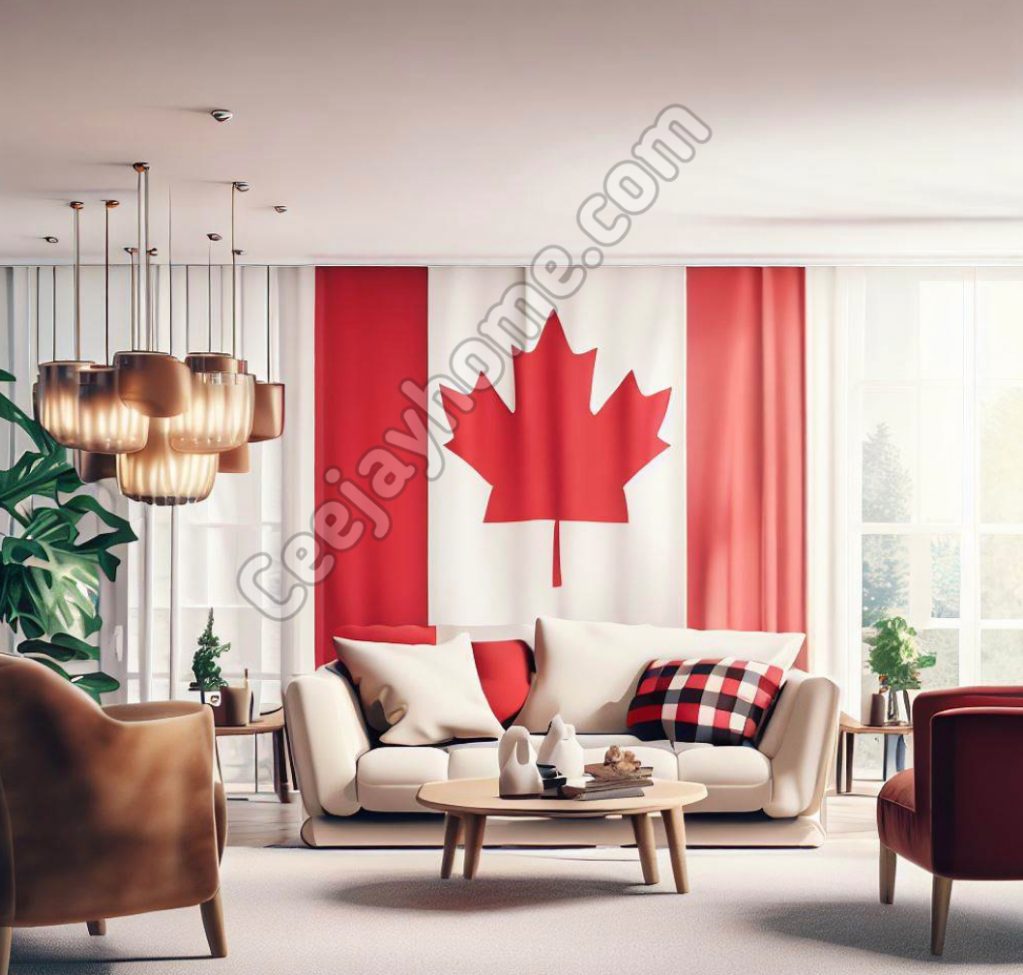
Canada-flag-home-decor-in-sitting-room
Table of Contents
Basic Guidelines and Flag Etiquette for decoration
- If you wish to hang the flag on a wall, make certain that it is smooth and unwrinkled. The proper orientation for display is either horizontally or vertically, with the upper part of the maple leaf pointing upward. In case of vertical display, ensure that the leaf is positioned to the left from the viewer’s perspective.
- If you plan on hoisting the flag on a pole outside your house, ensure that both the pole and flag are in good condition and clean. When raising it, do so briskly but lower it slowly with respect. Avoid letting it touch any objects or come into contact with the ground. Flying at half mast should strictly be reserved for mourning occasions.
- It is considered disrespectful and potentially harmful to use the flag as a dustbins or rags. Please refrain from doing so in order to preserve its integrity.
Note; These guidelines are based on commonly observed practices regarding displaying and handling flags respectfully in Canada.
To use the flag appropriately, it is advisable to refrain from using it for commercial purposes or as part of a costume.
If you wish to create your own country flag, you can easily do so with some fabric, scissors, glue and paint. Feel free to utilize your preferred coloring materials or paints, add stickers or glitter and even write slogans on one or both sides of the flag. Additionally, you can get creative by cutting out shapes like stars or moons from colored paper scraps and affixing them to your flag. When displaying it on a bulletin board, consider the thickness of the corkboard.
Check out: Russian flag: how to use the Russian symbol in decoration?(History, ideas, and where to buy)
When it comes to disposing of an old or damaged flag, it is important to handle this process in a dignified manner. You may choose to conduct a private ceremony where the flag is respectfully burned or bury it accordingly. Another option is cutting the flag into strips so that each element reduces down to a single color; these individual pieces should then be placed in a bag for proper disposal while avoiding reusing any shreds of fabric.
I hope these suggestions assist you in embellishing your home with the Canadian flag. In addition, you might want to explore decorative house flags that showcase various designs and themes associated with Canada such as animals, landscapes, sports or cultural motifs. Enjoy yourself and have fun!
How can I make an outdoor decoration with the Canadian flag?
Looking for ideas to create an outdoor decoration with the Canadian flag? There are plenty of creative options to consider. Here are a few suggestions;
One idea is to get a Canada garden flag, which showcases the iconic red and white maple leaf design. You can proudly display it on a flagpole, stake or hanger in your front yard, porch, balcony or patio. To prevent it from blowing away, you can also use anti wind clips. If you’re looking for examples and inspiration, websites like Amazon offer a variety of Canada garden flags.
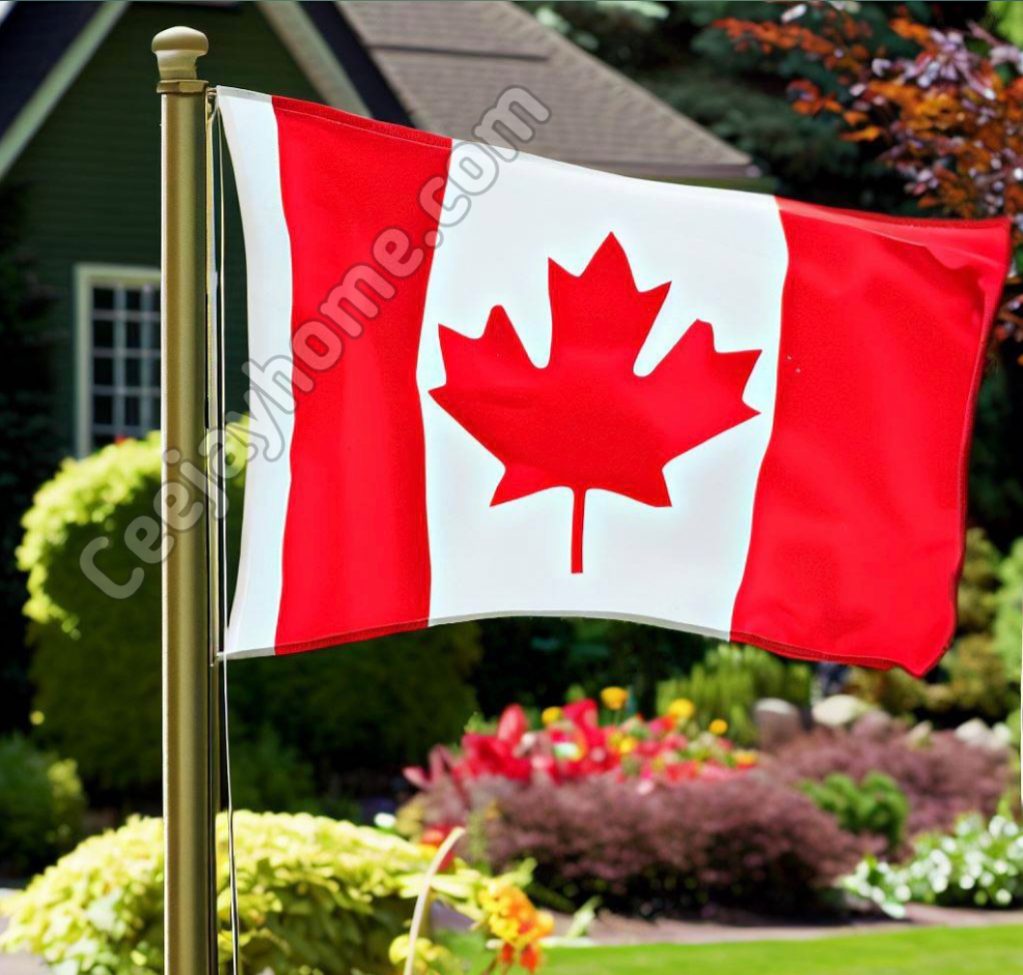
canadian-flag-garden-decoration-front-yard-flagpole
Another option is to use red and white lights to add a festive and patriotic touch. String them along your fence, roofline, windows or trees for an eye catching display. You can even get creative by shaping them into a maple leaf or spelling out words like “Canada” or “Eh”. Turn on these lights at night or during special occasions such as Canada Day or Victoria Day for an extra celebratory atmosphere.
If you enjoy crafting with your family or friends, consider making some Canadian themed crafts together. With materials like paper, cardboard, wood, fabric, paint, glue scissors and markers you can create unique pieces that showcase your love for Canada.
These ideas should help you bring the Canadian flag outdoors in a creative and visually appealing way!You have plenty of options when it comes to creating outdoor decorations with the Canadian flag theme. You can get creative and make maple leaf wreaths, banners, garlands, wind chimes, signs or ornaments. Hang them on your door, wall, railing or even on tree branches for a festive touch. If you need some inspiration and guidance, there are many online tutorials available to assist you.
Another idea is to incorporate red and white flowers into your garden or pots. Opt for flowers that are either native to Canada or bloom during the summer season. Tulips, roses, geraniums, petunias, carnations and poppies are excellent choices. You can arrange them in a pattern resembling the Canadian flag or mix them with some greenery for added contrast.
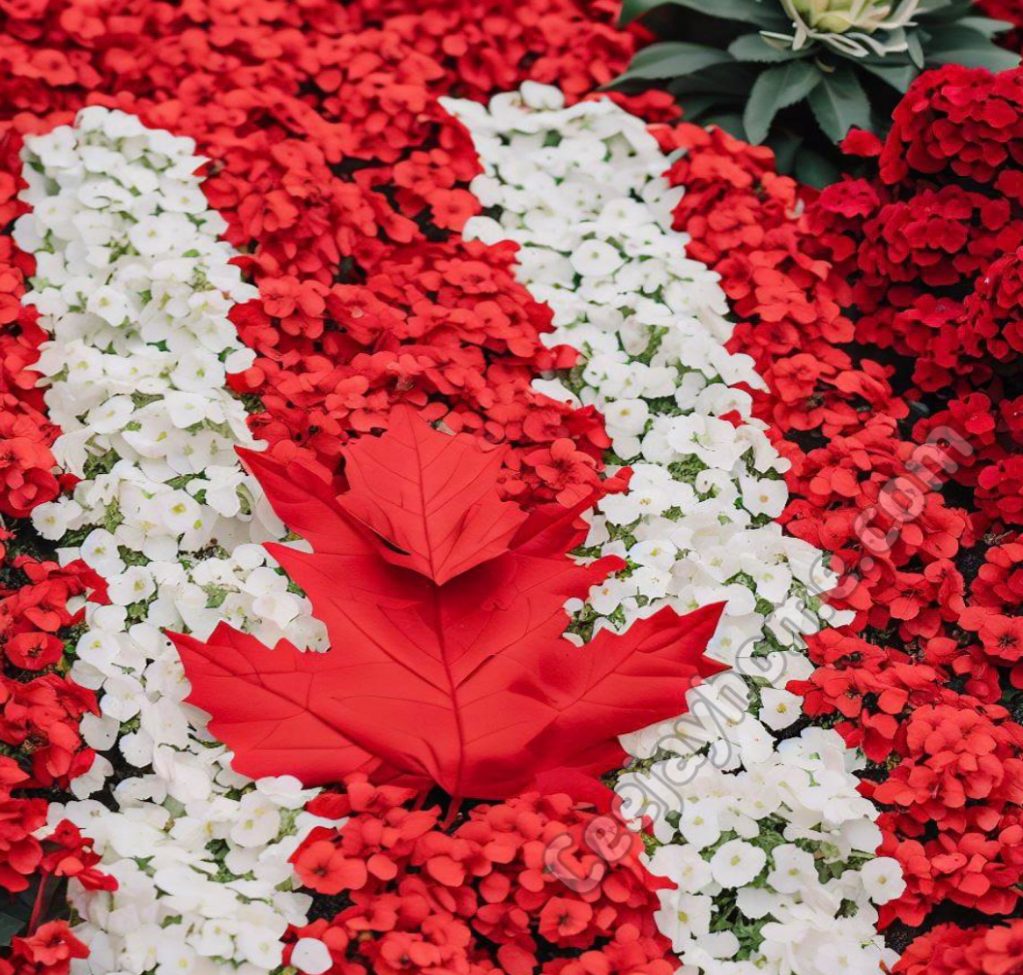
a-canadian-garden-with-red-white-flowers
I hope these suggestions provide you with creative ways to decorate outdoors using the Canadian flag theme. Enjoy the process and have fun!
History of the Canadian Flag
The Canadian flag has an interesting history. When the Canadian federation was established in 1867, there wasn’t a specific flag for the country. Instead, they used the Imperial Union Jack and other British flags. However, Queen Victoria granted them a coat of arms in 1868, which had the emblems of Ontario, Quebec, New Brunswick and Nova Scotia. This coat of arms was later added to the British Red Ensign in 1892 as a badge for Canadian ships. On land, people used this modified flag without permission as a way to show their Canadian patriotism while still loyal to Great Britain. Similar to how the United States adds stars to their flag when new states join, Canadians often added official provincial symbols to their coat of arms. These flags would sometimes feature the Imperial Crown, maple leaves wreaths or even a beaver. Despite all these changes over time, the Union Jack still flies proudly on Canadian soil.
In 1921, a significant change in symbols took place when Canada was granted a unique coat of arms. This new emblem consisted of England, Scotland, Ireland and France symbols quartered together with three green maple leaves on a silver background. After three years, this shield replaced the original one from 1868 in Canadian signs. In 1957, an updated artistic version was introduced featuring red maple leaves instead of green to symbolize the country’s maturity.
The desire for a distinctive Canadian flag grew after World War II. While the Canadian Red Ensign is acknowledged for government buildings and as the national flag overseas, many believe it fails to represent distinctive local culture and traditions accurately. A passionate debate ensued in 1964 following Prime Minister Lester B. Pearson’s pledge that Canada would have its own national flag before the centennial celebration of confederation in 1967. After months of public and parliamentary discussion, the new maple leaf flag received approval in December 1964. It was officially declared by royal proclamation on February 15, 1965 and has gained widespread support among Canadians ever since. The maple leaf has been a national symbol since at least 1868 and its red color is seen as representing Canadian sacrifice during World War I.
The first version of Pearson’s flag design featured three red maple leaves on a white background, with slim blue vertical stripes at each edge. Based on feedback from several individuals, the final version was modified by widening the stripes and changing them to red to highlight the national colors (red and white). The incorporation of a lone maple leaf in the center created a unique and easily identifiable symbol. Pearson’s initial flag design depicted three red maple leaves on a white field, accompanied by narrow blue vertical stripes at either end. Following input from various individuals, adjustments were made to the final design. This included widening the stripes and replacing them with red to accentuate the national colors (red and white). The addition of a solitary maple leaf served as a distinct and readily recognizable central emblem.
Home Decoration ideas with the Canadian flag
The Canada flag, with its vibrant colors and iconic design, can be used creatively to decorate your space. Here are some ideas for incorporating the Canadian flag into your home decoration:
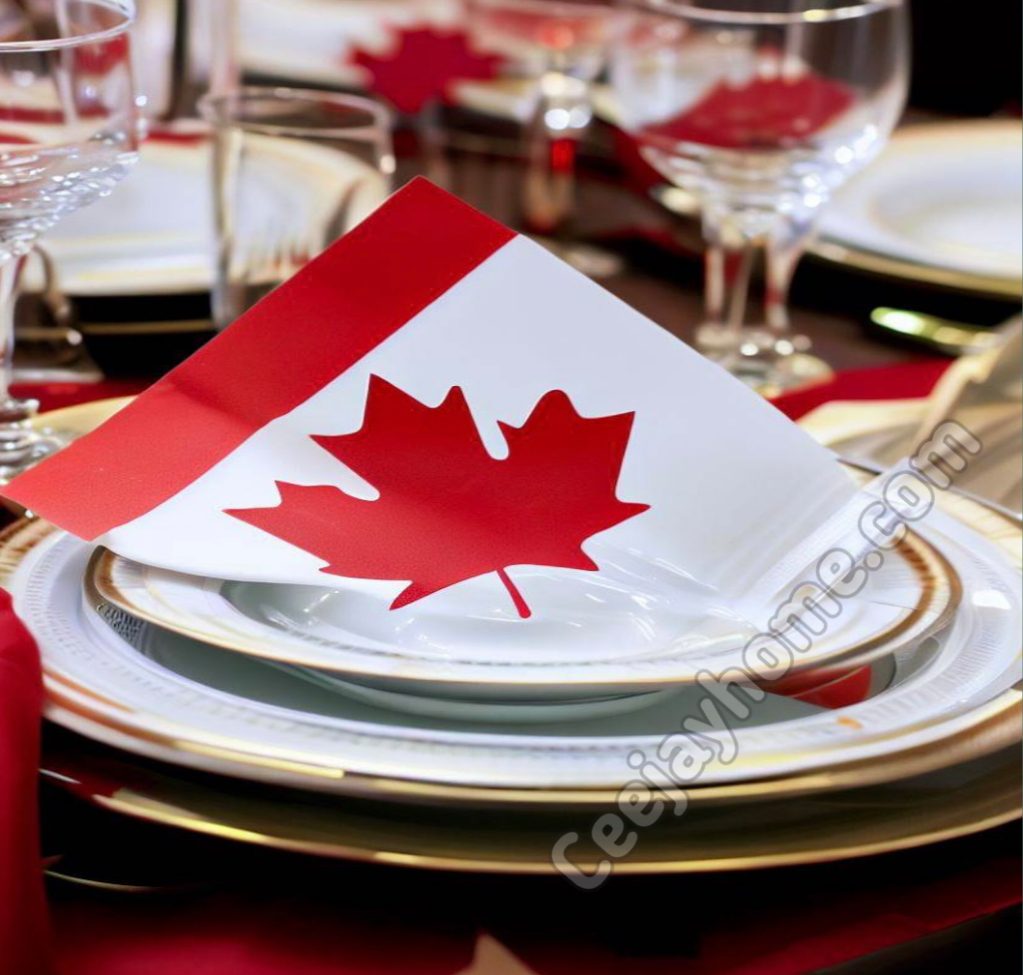
canadian-flag-plates-glasses-napkins-festive-meal
- Accent Wall: Hang a large Canadian flag on a wall to create a bold and patriotic focal point.
- Cushions and throws: Add cushions or throws with Canadian flag motifs to bring a touch of color and comfort to your living room or bedroom.
- Garlands: Create a garland with small Canadian flags to decorate your terrace, balcony or outdoor space during a national holiday or sporting event.
- Frames and Posters: Frame a Canadian flag or poster featuring the flag to create a piece of patriotic art.
- Tableware and table accessories: Use plates, glasses and napkins adorned with the Canadian flag for a festive meal.
- Clothing and accessories: Wear clothing or accessories in the colors of the Canadian flag to show your national pride.
- Crafts: Incorporate the Canadian flag into your craft projects, such as garlands, keychains or fridge magnets.
- Decals and Stickers: Decorate your laptop, phone, or office supplies with Canadian flag stickers.
- Bedding: Add a Canadian touch to your bedroom by choosing a bedding set in the colors of the flag.
- Rug: Look for a Canadian flag patterned rug to add a touch of patriotism to your home.
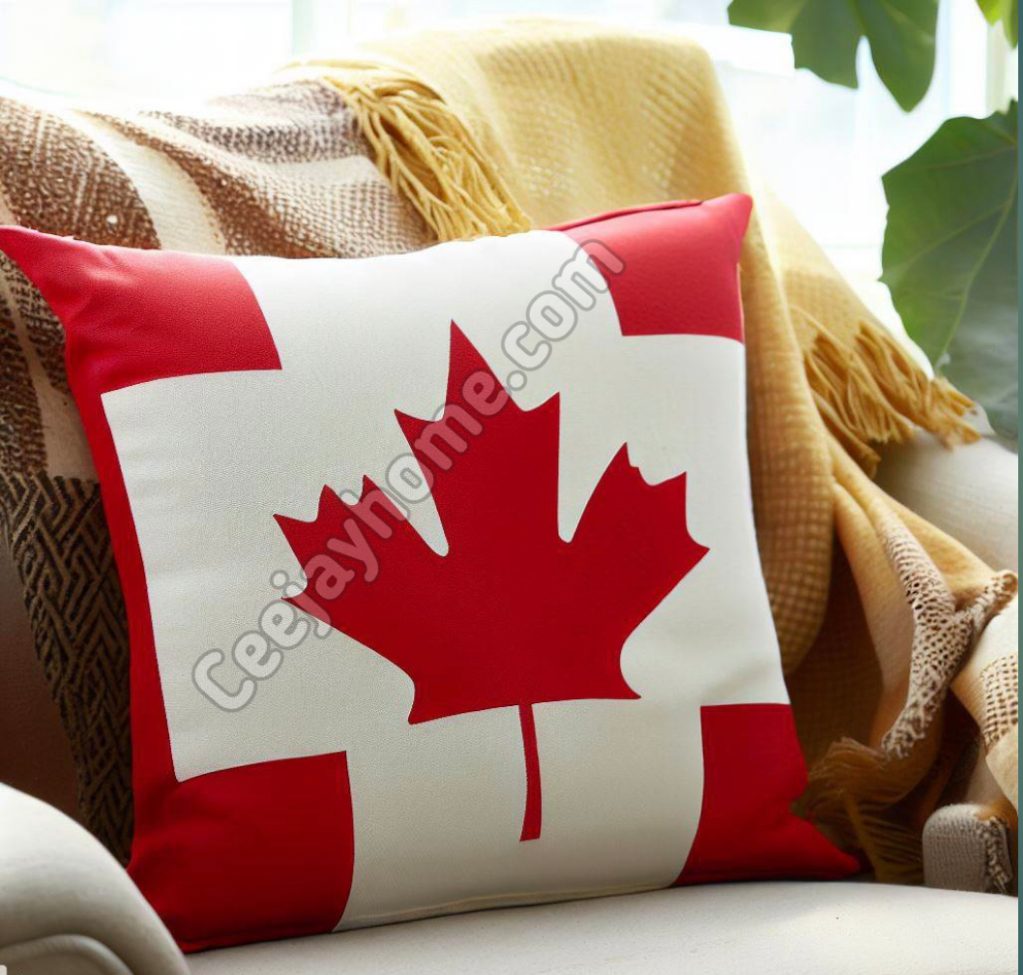
cushion-throw-pillow-canada-flag-theme-decoration-2
However you choose to use the Canadian flag to decorate your space, be sure to respect the flag and treat it with the care and consideration it deserves as a national symbol.
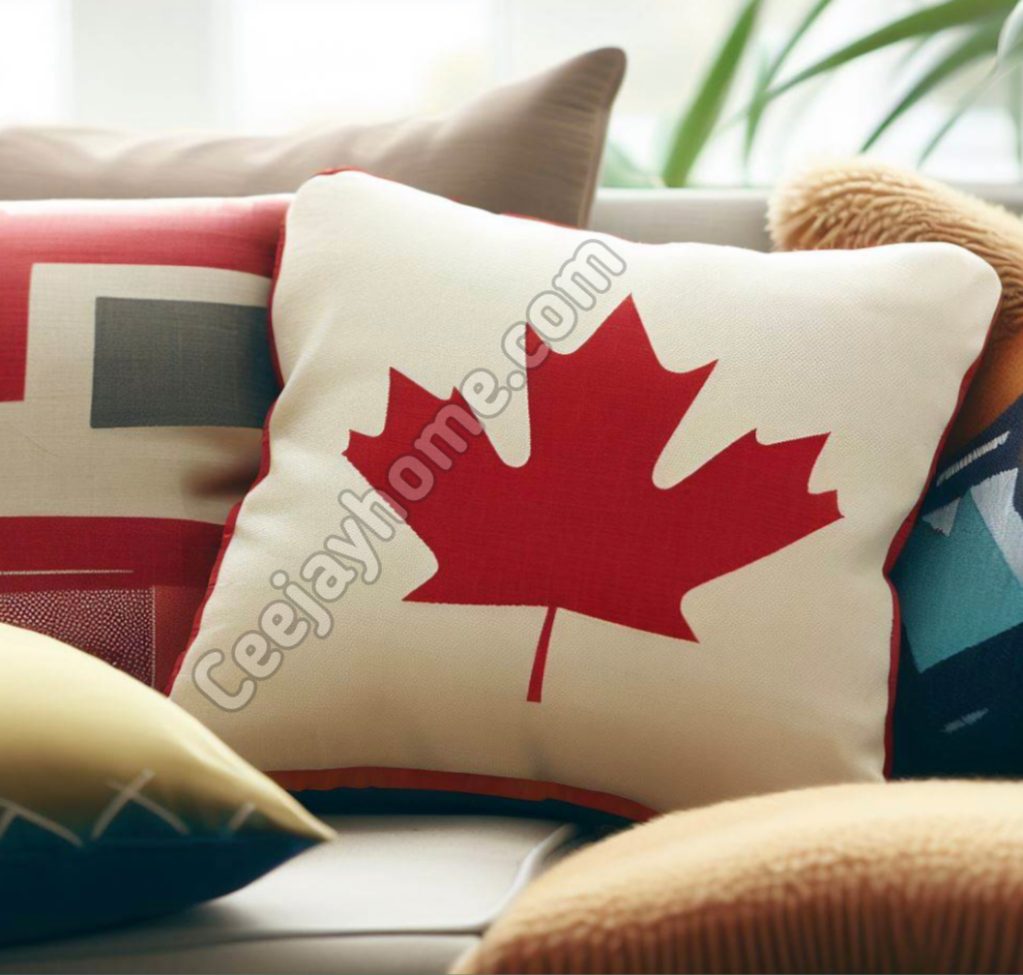
cushion-throw-pillow-canada-flag-theme-decoration
Where to buy the Canadian flag?
You can buy a Canadian flag in various places, online or in person. Here are some options to help you find a Canadian flag:
- Specialty flag stores: You may find a specialty flag store near you that sells the Canadian flag.
- Local markets or fairs: Local markets or craft fairs may sometimes feature flags, including the Canadian flag.
- Souvenir shops: If you are near a tourist area or a Canadian embassy, chances are the souvenir shops sell Canadian flags.
- Amazon: The e-commerce site Amazon offers a wide selection of flags, including the Canadian flag. You can find it by searching on their website.
- eBay: This auction and e-commerce site also offers new or used Canadian flags.
- AliExpress: This China-based e-commerce platform offers a variety of flags, including the Canadian flag, often at affordable prices.
- Etsy: If you’re looking for a handmade or vintage Canadian flag, Etsy is a good place to look.
Remember to compare prices and check the quality of the flag before purchasing. Also be sure to factor in shipping costs and delivery times if you’re buying online.